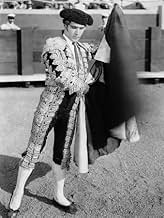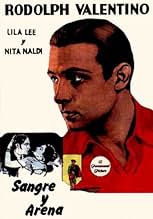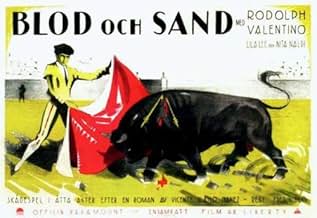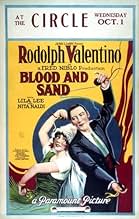VALUTAZIONE IMDb
6,3/10
1619
LA TUA VALUTAZIONE
La vita familiare e sociale di un torero è minacciata quando inizia una relazione proibita.La vita familiare e sociale di un torero è minacciata quando inizia una relazione proibita.La vita familiare e sociale di un torero è minacciata quando inizia una relazione proibita.
- Regia
- Sceneggiatura
- Star
- Premi
- 1 vittoria in totale
Rudolph Valentino
- Juan Gallardo
- (as Rodolph Valentino)
Rosa Rosanova
- Angustias
- (as Rose Rosanova)
W.E. Lawrence
- Fuentes
- (as William Lawrence)
Michael Dark
- Doña Sol's New Lover
- (non citato nei titoli originali)
Recensioni in evidenza
Rudolph Valentino was every woman's dream, except after he ate his favorite Italian meal for lunch, heavily laden with a good dose of spicy garlic. His breath, needless to say, had the lingering smell of an undesirable odor. Lina Lee, who played his love interest Carmen in August 1922's "Blood and Sand," after getting a whiff during a lingering kiss on set, insisted their love scenes be filmed before lunch.
The story of Juan Gallardo, based on Vincente Ibanez's 1909 of the same name, could easily act as a parallel to the actor playing the matador, Valentino, as well as his life. Juan is a poor village boy much like the actor when he immigrated to the United States. In the book the young man emerges despite discouraging words from his parents as one of the greatest matadors in Spain. He marries his village childhood sweetheart, Carmen, after achieving fame in the bullring. While exhibiting on the road, however, he falls in love with a conniving seductive, yet shallow, wealthy widow. Guilt ridden about the affair, he becomes reckless in the arena.
"Blood and Sand" was filmed in the middle of the actor's involvement with his girlfriend, Natacha Rambova, while still legally married to his first wife, despite their divorce filings. Under contract with the Famous Players-Lasky Studios, Valentino was upset with their switch in shooting locales after they originally planned to film in Spain. The actor was anticipating visiting his relatives in Italy around breaks in production after a 10-year absence from seeing them. He also became unhappy with his mediocre salary despite his employers enjoying a bonanza at the box office with his every movie. With all the conflict and personal tribulations, "Blood and Sand," Valentino's favorite movie he appeared in, was the third highest grossing film of the year, piling on the money the studio was making off their prized popular actor.
For Mary Pickford, among the many critics who loved the movie, said "In my judgement it was the best thing he has done. It is one of the few pictures I have been able to sit through twice and enjoy the second time more than the first."
"Blood and Sand" also proved to be a pivotal picture for Dorothy Azner. Jumping into the movie business soon after she soured from becoming a doctor, she received a job with Paramount through Cecil's brother William DeMille's guidance. Typing scripts, Azner soon learned the art of film editing. She drew the assignment to edit "Blood and Sand," where she saved the studio thousands of dollars by obtaining stock footage of actual bullfights to intercut with the shots of Valentino and other actors acting as matadors in the ring. She even assisted director Fred Niblo (not Valentino's choice as a director, another point of contention he had with the studio) in the bullfighting scenes, positioning the actors to coincide with her stock footage. Soon after her highly praised job as an editor, Azner was able to leverage her talents to become a very successful movie director.
The story of Juan Gallardo, based on Vincente Ibanez's 1909 of the same name, could easily act as a parallel to the actor playing the matador, Valentino, as well as his life. Juan is a poor village boy much like the actor when he immigrated to the United States. In the book the young man emerges despite discouraging words from his parents as one of the greatest matadors in Spain. He marries his village childhood sweetheart, Carmen, after achieving fame in the bullring. While exhibiting on the road, however, he falls in love with a conniving seductive, yet shallow, wealthy widow. Guilt ridden about the affair, he becomes reckless in the arena.
"Blood and Sand" was filmed in the middle of the actor's involvement with his girlfriend, Natacha Rambova, while still legally married to his first wife, despite their divorce filings. Under contract with the Famous Players-Lasky Studios, Valentino was upset with their switch in shooting locales after they originally planned to film in Spain. The actor was anticipating visiting his relatives in Italy around breaks in production after a 10-year absence from seeing them. He also became unhappy with his mediocre salary despite his employers enjoying a bonanza at the box office with his every movie. With all the conflict and personal tribulations, "Blood and Sand," Valentino's favorite movie he appeared in, was the third highest grossing film of the year, piling on the money the studio was making off their prized popular actor.
For Mary Pickford, among the many critics who loved the movie, said "In my judgement it was the best thing he has done. It is one of the few pictures I have been able to sit through twice and enjoy the second time more than the first."
"Blood and Sand" also proved to be a pivotal picture for Dorothy Azner. Jumping into the movie business soon after she soured from becoming a doctor, she received a job with Paramount through Cecil's brother William DeMille's guidance. Typing scripts, Azner soon learned the art of film editing. She drew the assignment to edit "Blood and Sand," where she saved the studio thousands of dollars by obtaining stock footage of actual bullfights to intercut with the shots of Valentino and other actors acting as matadors in the ring. She even assisted director Fred Niblo (not Valentino's choice as a director, another point of contention he had with the studio) in the bullfighting scenes, positioning the actors to coincide with her stock footage. Soon after her highly praised job as an editor, Azner was able to leverage her talents to become a very successful movie director.
Although in many ways "Blood and Sand" looks rather old-fashioned now, it's still an interesting drama. It gives Rudolph Valentino one of his better roles, and it is also highlighted by an effective supporting performance from Nita Naldi. The subject matter has some substance to it, and it still holds up well enough despite being handled occasionally in a somewhat heavy-handed manner.
In playing the bullfighter Gallardo, Valentino gets a character with some depth to it. The story follows him as he first struggles to achieve fame and respect, and then struggles in dealing with the side-effects of fame, fortune, and popularity. Naldi's role is memorable, and from her first appearance she makes her manipulative vamp character physically desirable but an obvious source of danger. Valentino does a good job playing off of her, and even without the benefit of spoken dialogue it is easy to see the struggle and self-reproach taking place inside of him.
The themes have a significance that go beyond the original setting. In itself, the criticisms of bullfighting and of what it reveals about human nature, while generally quite valid, are put forth without any subtlety. The inter-titles and the obvious parallels between Gallardo and the notorious criminal Plumitas repeatedly emphasize the same points that the action itself could have made well enough on its own. But that's one of the few weaknesses of "Blood and Sand". And the more general point, its depiction of how easy it is for crowds to be thrilled with violence, is well-taken.
The one other noticeable shortcoming is that the bullring scenes are now often unconvincing. It is laudable, of course, that the film-makers were willing to sacrifice realism so as to avoid being cruel to the animals, so this particular aspect of the movie should be evaluated generously. Present-day technology would certainly have made it much simpler to achieve both goals.
Although the style might make it mostly of interest to those who are already silent movie fans, there is still more than enough of interest to make this worth seeing. The story is simple, but it has some worthwhile aspects. Naldi provides something striking to look at, and Valentino gets to show what he can do with a role that has some possibilities to it.
In playing the bullfighter Gallardo, Valentino gets a character with some depth to it. The story follows him as he first struggles to achieve fame and respect, and then struggles in dealing with the side-effects of fame, fortune, and popularity. Naldi's role is memorable, and from her first appearance she makes her manipulative vamp character physically desirable but an obvious source of danger. Valentino does a good job playing off of her, and even without the benefit of spoken dialogue it is easy to see the struggle and self-reproach taking place inside of him.
The themes have a significance that go beyond the original setting. In itself, the criticisms of bullfighting and of what it reveals about human nature, while generally quite valid, are put forth without any subtlety. The inter-titles and the obvious parallels between Gallardo and the notorious criminal Plumitas repeatedly emphasize the same points that the action itself could have made well enough on its own. But that's one of the few weaknesses of "Blood and Sand". And the more general point, its depiction of how easy it is for crowds to be thrilled with violence, is well-taken.
The one other noticeable shortcoming is that the bullring scenes are now often unconvincing. It is laudable, of course, that the film-makers were willing to sacrifice realism so as to avoid being cruel to the animals, so this particular aspect of the movie should be evaluated generously. Present-day technology would certainly have made it much simpler to achieve both goals.
Although the style might make it mostly of interest to those who are already silent movie fans, there is still more than enough of interest to make this worth seeing. The story is simple, but it has some worthwhile aspects. Naldi provides something striking to look at, and Valentino gets to show what he can do with a role that has some possibilities to it.
Most people picture Rudolph Valentino from his earlier roles in "Four Horsemen Of The Apocalypse" or "The Sheik". In this movie, Valentino plays a Matador in Spain and the story traces his rise and fall. Yes, he certainly was handsome and you see traces of his definate appeal here. For me, though, the movie was stolen by "the other woman", Dona Sol. She tarts her role up real well and plays it very broad, almost shockingly brazen for it's time. The scene where she tells Valentino that she longs to fell him beat her will make us wince, then she bites his hand while while in a semi-embrace in order to raise his passions. All stuff that seems pretty extreme for the typical innocent silent movie woman roles. The ending will be no surprise, it is telegraphed and alluded to many times during the movie. It's not Rudy at his absolute best, but I can recommend it.
I've watched "Blood and Sand" several times; I own the DVD. With every viewing I notice some new subtle nuance in the under played gestures of Valentino. In the big seduction scene between Valentino and the voluptuous Nita Naldi, she sits at a harp, delicately playing, with her back to Valentino. He walks up behind her chair, clearly aroused, and he begins to seductively stroke the chair! This is so under played and yet so visually compelling and sensuous.It is so unlike the melodramatic rather hystrionic aesthetic so often found in films from this period. Valentino's restraint throughout the film's more emotional moments is compelling; his subtlety pulls the viewer intimately inward.True, the bull fighting scenes leave a bit to be desired. They are the result of some rather choppy editing and sadly come off looking peculiar,even humorous at times. Somehow Valentino pulls it off, his graceful movements, his quiet emotions, his compelling sensuality more than make up for the lack of authenticity in the bullring.
BLOOD AND SAND is one of those rare movies where the remake is actually much better--and this isn't because the remake was a sound movie and this one was silent. The problem is that the original Valentino film was a very traditional morality play that tried to please the more conservative film viewer of the day and ended up being rather heavy-handed and lacked depth. So, despite this being a film by America's most loved male sex symbol of the day, it is very pro-family and discusses the evils of extramarital affairs in a very obvious and superficial manner (the remake is slower paced and less preachy). This is odd, by the way, when you compare this film with two of Valentino's other famous performances. In THE SHIEK, there is a lot of sexual tension and the film is pretty racy for its day, as was THE FOUR HORSEMEN OF THE APOCALYPSE (which even included some nudity). It really is interesting how none of these films represent the average viewer--the movie is either anti-sex (like BLOOD AND SAND) or very pro-sex (like the other two). A truly interesting dichotomy.
Lo sapevi?
- QuizThe film's editor was Dorothy Arzner, who would later go on to become Hollywood's first female director. Arzner impressed the producers by cannily interspersing stock bull-fighting footage with shots of Rudolph Valentino to make it look like the actor was actually in the ring with real bulls. This was quite a progressive technique in its day.
- BlooperThe mountain bandit who is one of the principal supporting characters is an anachronism; the Guardia Civil did away with their kind during the late 19th century.
- Citazioni
Juan Gallardo: We spread our capes for your amusement and most generous alms.
- ConnessioniEdited into Michael Blanco (2004)
I più visti
Accedi per valutare e creare un elenco di titoli salvati per ottenere consigli personalizzati
- How long is Blood and Sand?Powered by Alexa
Dettagli
Botteghino
- Lordo Stati Uniti e Canada
- 2.725.000 USD
- Tempo di esecuzione
- 1h 48min(108 min)
- Mix di suoni
- Proporzioni
- 1.33 : 1
Contribuisci a questa pagina
Suggerisci una modifica o aggiungi i contenuti mancanti

























